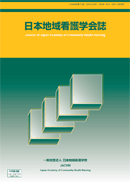Volume 11, Issue 1
Displaying 1-9 of 9 articles from this issue
- |<
- <
- 1
- >
- >|
-
Article type: Article
2008 Volume 11 Issue 1 Pages 39-45
Published: September 30, 2008
Released on J-STAGE: April 20, 2017
Download PDF (1079K) -
Article type: Article
2008 Volume 11 Issue 1 Pages 46-52
Published: September 30, 2008
Released on J-STAGE: April 20, 2017
Download PDF (1158K) -
Article type: Article
2008 Volume 11 Issue 1 Pages 53-58
Published: September 30, 2008
Released on J-STAGE: April 20, 2017
Download PDF (870K) -
Article type: Article
2008 Volume 11 Issue 1 Pages 59-67
Published: September 30, 2008
Released on J-STAGE: April 20, 2017
Download PDF (1584K) -
Article type: Article
2008 Volume 11 Issue 1 Pages 68-75
Published: September 30, 2008
Released on J-STAGE: April 20, 2017
Download PDF (1153K) -
Article type: Article
2008 Volume 11 Issue 1 Pages 76-80
Published: September 30, 2008
Released on J-STAGE: April 20, 2017
Download PDF (807K) -
Article type: Article
2008 Volume 11 Issue 1 Pages 81-86
Published: September 30, 2008
Released on J-STAGE: April 20, 2017
Download PDF (874K) -
Article type: Article
2008 Volume 11 Issue 1 Pages 87-92
Published: September 30, 2008
Released on J-STAGE: April 20, 2017
Download PDF (999K) -
Article type: Article
2008 Volume 11 Issue 1 Pages 93-99
Published: September 30, 2008
Released on J-STAGE: April 20, 2017
Download PDF (905K)
- |<
- <
- 1
- >
- >|
